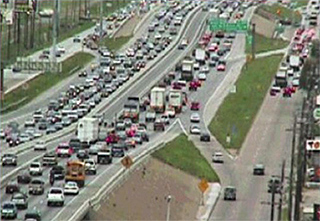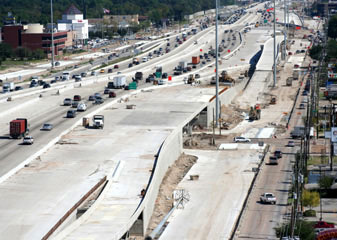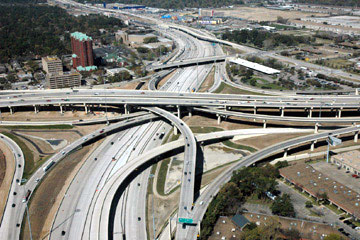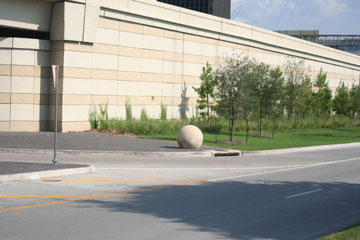Engineering Freeways
by Andrew Boyd
Today, stuck in traffic. The University of Houston's College of Engineering presents this series about the machines that make our civilization run, and the people whose ingenuity created them.
Sitting on the freeway. Traffic as far as you can see. It's frustrating. Can't civil engineers do a better job of designing and building roads?

A typical day on the Katy Freeway prior to reconstruction.
I've heard a lot of that as I've watched reconstruction of one Houston's busiest freeways. It's part of Interstate 10, the southern-most freeway in the U.S. — connecting Los Angeles to Jacksonville, Florida. The makeover's for a stretch of road called the Katy Freeway that extends west from Houston to the city of Katy. It's travelled by the "Katy crawlers" — a name for the suburban commuters who depend on it.

Traffic needs to keep moving while reconstruction is underway.
Groundbreaking for the road's reconstruction took place in June of 2003. Work is scheduled for completion in early 2009. Five and a half years for twenty-three miles of road. That's a long time for struggling drivers. But it's a short time for such a complicated project. And, thanks to innovative funding, the time's half as long as originally planned.

The nearly completed Katy Freeway as it intersects another major freeway.
The reality is that building freeways is a huge engineering feat. And it's especially tough in an already busy urban corridor. Concrete must be poured, bridges built, and road signs put up. But many parts of the job aren't as visible.
Property rights and utilities are one issue. The Katy freeway is now much wider, having expanded from eleven to eighteen lanes — including the one-way frontage roads that parallel the limited access lanes. Of the estimated 2.8 billion dollars spent on the project, one of every four was spent freeing-up land. The issue's not just money. It's people. It's about finding a solution that makes everyone satisfied; or, at least, trying to.
Financing needs to be arranged. Contracts put out for bid. Environmental impact statements completed. Landscaping and aesthetics considered. Structural designs reviewed and approved. And plans made to keep traffic moving while the work goes on. The original Katy freeway was designed to carry seventy thousand cars per day. When reconstruction began, it was carrying over two-hundred thousand. And all those cars carry people — people who watch the work progress day in and day out. People who'd rather be anywhere than staring at the car stopped in front of them, wondering when — if ever — they'll be able to travel the posted speed limit. The Katy crawlers will breathe a huge sigh of relief when the freeway's finished. It'll make a real difference in their lives.

Aesthetics are an important part of the project.
It's easy to find fault with freeways. They're noisy. They're a source of pollution. They lead to urban sprawl. We can't afford to build them without considering the long term consequences.
But they're also a practical necessity — at least for now. And as engineering projects go they're impressive — sometimes even eye-catching. The next time you drive to work, think about the road you're traveling — literally, not metaphorically. It may not be perfect, but where would you be without it?
I'm Andy Boyd at the University of Houston, where we're interested in the way inventive minds work.
See: R. Sallee. Down the Home Stretch on Katy Freeway Widening. HoustonChronicle. January 14, 2008. See also: http://www.chron.com/disp/story.mpl/metropolitan/5450155.html. Accessed July 14, 2008.
Photo of traffic prior to reconstruction taken from the slide presentation “Katy Freeway Project” by Melissa Owen, Texas Department of Transportation, May 17, 2005; The remaining pictures are taken from a web site of the Texas Department of Transportation.